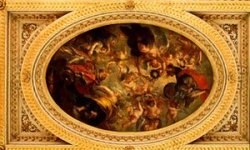British Renaissance Architecture
 Whitehall banqueting House ceiling, painted by Rubens. Photograph: Alamy
Whitehall banqueting House ceiling, painted by Rubens. Photograph: Alamy
The Renaissance entered Britain tardily, and on tip-toe. When Henry VII demolished the old Lady Chapel of Westminster Abbey in 1502, he replaced it with something more extravagantly gothic, with pointed arches, pendant fan vaulting and a plethora of crockets. Nevertheless, when it came to Henry's tomb, and later the high altar, Florentine artists were commissioned to carry out the work in the latest style.
So insouciant a combination is typical of the English Renaissance. Enter Cambridge's Caius College by its elegant Renaissance Gate of Honour and you find yourself in a small, unreconstructed medieval courtyard, but there is no feeling of discordancy or even disconnection. Gate and courtyard share material, scale and feeling. English 16th-century builders domesticated influences from Europe and blended them into the eclectic and eccentric agglomeration that we still revere as Tudor.
Renaissance detail came as a stylish add-on to structures that had stood over centuries. The landlord who bought himself a medieval abbey after the dissolution of the monasteries could happily secularise it by adding pagan detail. The scale of English Renaissance buildings remains human and intimate, despite the sometimes colossal pretensions of the magnates who built them.
None were more colossal than those of Cardinal Wolsey, but even he built his palace at Hampton Court on the same lines. Henry VIII, who already had the palaces of Westminster, Greenwich, Richmond and St James, extended the two he confiscated from Wolsey, and set about making one of them, York House, into the sprawling muddle that was Whitehall.
There were few architects in Tudor England. Individuals designed their own building projects, so we are not surprised to find the layout of the new mansions mirrored those of existing farmhouses, with a single central hall rising to the full height of the building, connected by staircases to apartments on several floors. As the houses grew larger and the proprietors richer, the wings were embellished with porches and colonnades, balustrades and turrets. Such buildings were meant to be elegant and practical rather than grandiose, and this remains their charm. As the pace of agricultural reform quickened under Elizabeth I, the number and size of country houses grew. Decoration became more elaborate, but the basic design remained much the same.
Elizabeth I's reign marks the mid-point of the "great rebuilding", during which the English housing stock was renovated. The improvements ranged from the basic – putting in floors, flues and walls; glazing windows; replacing wattle and daub with brick, and thatch with tile; to the ostentatious – cladding brick walls with marble and surrounding pitched roofs with parapets. Elizabeth encouraged such efforts at no expense to herself by going on royal progresses each spring and summer, prompting the gentry and the civic authorities to vie for the honour of housing her and her entourage.
Ben Jonson lived most of his life as a non-paying guest in the houses of the gentry. In the poem To Penshurst (c1600), he leaves us a record of Penshurst Place as not "built to envious show" but with walls "of country stone". It praises not a monument, but a household that serves its community, welcomes guests and, most importantly, provides a good table. The literary model for such an exercise was the Roman poet Horace, but the subject was homegrown English. To Penshurst spawned a genre of estate poems that lasted well into the 18th century.
When the Academy of Vicenza needed a theatre in 1579, the Italian architect Andrea Palladio designed it on a classical model drawn from Vitruvius. In 1599, when a new theatre on Bankside was needed, James Burbage and his colleagues simply pulled down their old theatre and used the materials to build a virtual replica, which they called the Globe. Palladio's theatre was built inside another building, for an audience of cultivated patricians; the Globe was built outdoors for a general public, and so was serviceable and commodious rather than magnificent. The Globe, as it has now been reconstructed, works stunningly well as a theatre; Palladio's theatre, for all its undeniable beauty, didn't.









